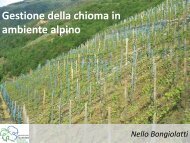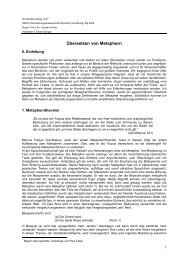Current Opinion in Investigational Drugs
Current Opinion in Investigational Drugs
Current Opinion in Investigational Drugs
You also want an ePaper? Increase the reach of your titles
YUMPU automatically turns print PDFs into web optimized ePapers that Google loves.
16 <strong>Current</strong> <strong>Op<strong>in</strong>ion</strong> <strong>in</strong> <strong>Investigational</strong> <strong>Drugs</strong> 2006 Vol 7 No 1<br />
<strong>in</strong>teractions that may form the scaffold for functional genomics<br />
and proteomics, that has emerged from the recently published<br />
draft of the human haplotype map (HapMap) [37,38]. HapMap<br />
is anticipated to 'provide <strong>in</strong>sight <strong>in</strong>to development and disease<br />
mechanisms at a systems level' and to facilitate genome-wide<br />
association studies, represent<strong>in</strong>g a major step forward <strong>in</strong><br />
understand<strong>in</strong>g human disease etiology, provided that the same<br />
concerns regard<strong>in</strong>g data replication that are prevalent <strong>in</strong> the<br />
genome [39], and more so <strong>in</strong> the proteome [36], are not a<br />
function of the enhanced complexity and practice of the<br />
<strong>in</strong>teractome [40].<br />
While there is early enthusiasm for the promise of the<br />
<strong>in</strong>teractome (the 'technology trigger' phase of the hype cycle)<br />
Sharon Begley of the Wall Street Journal (who brought the<br />
world the parts model of the Boe<strong>in</strong>g 777 as a metaphor for<br />
the reductionistic approach to decipher<strong>in</strong>g the genome) [41]<br />
has questioned the 'limited' value of the HapMap [19] <strong>in</strong> the<br />
context of tw<strong>in</strong> studies [42] <strong>in</strong> which identical DNA and<br />
haplotypes lead to different phenotypes.<br />
Dur<strong>in</strong>g the course of this year, <strong>Current</strong> <strong>Op<strong>in</strong>ion</strong> <strong>in</strong><br />
<strong>Investigational</strong> <strong>Drugs</strong> hopes to present a series of Editorials,<br />
written or suggested by members of its Editorial Board, that<br />
are focused on the challenges and progress <strong>in</strong> utiliz<strong>in</strong>g<br />
<strong>in</strong>formation from the genome and its 'omic' progeny <strong>in</strong> the<br />
context of both discrete therapeutic areas and genomeassociated<br />
technology platforms. In an era of considerable<br />
scepticism as to the value of new biologies [9,18] and their<br />
ability to be <strong>in</strong>tegrated with more traditional approaches to<br />
drug discovery [43], the capacity of these discipl<strong>in</strong>es to add<br />
to the solutions, rather than the problems that are deemed to<br />
be contribut<strong>in</strong>g to the dearth of new drug <strong>in</strong>troductions [8,<br />
43,44], will be reviewed.<br />
Suggested read<strong>in</strong>g<br />
1. Lander ES, L<strong>in</strong>ton LM, Birren B, Nusbaum C, Zody MC, Baldw<strong>in</strong> J,<br />
Devon K, Dewar K, Doyle M, Fitz Hugh W, Funke R et al: Initial<br />
sequenc<strong>in</strong>g and analysis of the human genome. Nature (2001)<br />
409(6822):860-921.<br />
2. Venter JC, Adams MD, Myers EW, Li PW, Mural RJ, Sutton GG, Smith<br />
HO, Yandell M, Evans CA, Holt RA, Gocayne JD et al: The sequence<br />
of the human genome. Science (2001) 291(5507):1304-1351.<br />
3. Coll<strong>in</strong>s FS, Morgan M, Patr<strong>in</strong>os A: The human genome project:<br />
Lessons from large-scale biology. Science (2003) 300(5617):286-<br />
290.<br />
4. Moore SD: Biotechnology executives discuss the impact of the<br />
genetic revolution. Wall Street Journal (2000) July 24:B10-B11.<br />
5. Coll<strong>in</strong>s FS, Green ED, Guttmacher AE, Guyer MS: A vision for the<br />
future of genomics research. Nature (2003) 422(6934):835-847.<br />
6. Stoughton RB, Friend SH: How molecular profil<strong>in</strong>g could<br />
revolutionize drug discovery. Nat Rev Drug Discov (2005) 4(4):345-<br />
350.<br />
7. Belk<strong>in</strong> L: A doctor for the future. New York Times Magaz<strong>in</strong>e (2005)<br />
November 06:68-115.<br />
8. Carney S: How can we avoid the productivity gap? Drug Disc Today<br />
(2005) 10(15):1011-1013.<br />
9. Carney S: Question: What do you call 500 scientists com<strong>in</strong>g<br />
together to address the productivity gap? Answer: A start. Drug<br />
Disc Today (2005) 10(15):1025-1029.<br />
10. Lehman Brothers/McK<strong>in</strong>sey & Co: The Fruits of Genomics. New York,<br />
NY, USA (2001) January.<br />
11. Weatherall D: Personalised medic<strong>in</strong>es: Hopes and realities. Royal<br />
Society, London, UK (2005):1-52.<br />
12. Drews J: Strategic trends <strong>in</strong> the drug <strong>in</strong>dustry. Drug Disc Today<br />
(2003) 8(9):411-420.<br />
13. Osbourne E: After plateau, 'big growth phase' due for<br />
biotechnology: Vagelos. BioWorld Today (2005): May 25.<br />
14. Frantz S: Europe fiddles while <strong>in</strong>novation burns. Nat Rev Drug<br />
Discov (2005) 4(9):704-705.<br />
15. Black J: A personal perspective on Dr Paul Janssen. J Med Chem<br />
(2005) 48(6):1687-1688.<br />
16. Sams-Dodd F: Optimiz<strong>in</strong>g the discovery organization for<br />
<strong>in</strong>novation. Drug Disc Today (2005) 10(15):1049-1056.<br />
17. Jones S: Genetics <strong>in</strong> Medic<strong>in</strong>e: Real Promises, Unreal<br />
Expectations. Milbank Memorial Fund Report (2000) 9:June.<br />
18. Kub<strong>in</strong>yi H: Drug research: Myths, hype and reality. Nat Rev Drug<br />
Discov (2003) 2(8):665-668.<br />
19. Guttmacher AE, Coll<strong>in</strong>s FS: Realiz<strong>in</strong>g the promise of genomics <strong>in</strong><br />
biomedical research. J Am Med Assoc (2005) 294(11):1399-1402.<br />
20. Begley S: L<strong>in</strong>k<strong>in</strong>g DNA profiles to diseases may not lead to<br />
prevention. Wall Street Journal (2005) November 04:B1.<br />
21. L<strong>in</strong>den A, Fenn J: Understand<strong>in</strong>g Gartner's hype cycles. Research ID<br />
R-20-197, Gartner, Stamford, CT, USA (2003).<br />
22. Marx J: Neurodegeneration: Hunt<strong>in</strong>gton's research po<strong>in</strong>ts to<br />
possible new therapies. Science (2005) 310(5745):43-45.<br />
23. Edwards CL, Scales MT, Loughl<strong>in</strong> C, Bennett GG, Harris-Peterson S,<br />
De Castro LM, Whitworth E, Abrams M, Feliu M, Johnson S, Wood M et<br />
al: A brief review of the pathophysiology, associated pa<strong>in</strong>, and<br />
psychosocial issues <strong>in</strong> sickle cell disease. Int J Behav Med (2005)<br />
12(3):171-179.<br />
24. Rubenste<strong>in</strong> RC: Novel, mechanism-based therapies for cystic<br />
fibrosis. Curr Op<strong>in</strong> Pediatr (2005) 17(3):385-392.<br />
25. Forman MS, Trojanowski JQ, Lee VM-Y: Neurodegenerative<br />
diseases: A decade of discoveries paves the way for therapeutic<br />
breakthroughs. Nat Med (2004) 10(10):1055-1063.<br />
26. Fenili D, McLaur<strong>in</strong> J: Cholesterol and ApoE: A target for Alzheimer's<br />
disease therapeutics. Curr Drug Targets CNS Neurol Disord (2005)<br />
4(5):553-567.<br />
27. Whalen J: Brita<strong>in</strong> stirs outcry by weigh<strong>in</strong>g benefits of drugs versus<br />
price. Wall Street Journal (2005) November 27:A1-A11.<br />
28. Avorn J: Powerful Medic<strong>in</strong>es: The Benefits, Risks and Costs of<br />
Prescription <strong>Drugs</strong>. Knopf, New York, NY, USA (2004):1-464.<br />
29. Langley K, Turic D, Peirce TR, Mills S, Van Den Bree MB, Owen MJ,<br />
O'Donovan MC, Thapar A: No support for association between the<br />
dopam<strong>in</strong>e transporter (DAT1) gene and ADHD. Am J Med Genetics<br />
Part B: Neuropsychiatric Genetics (2005) 139(1):7-10.<br />
30. Couz<strong>in</strong> J: Choices−and uncerta<strong>in</strong>ties−for women with BRCA<br />
mutations. Science (2003) 302(5645):592.<br />
31. Des Georges M, Guittard C, Altieri J-P, Templ<strong>in</strong> C, Sarles J, Sarda P,<br />
Claustres M: High heterogeneity of CFTR mutations and unexpected<br />
low <strong>in</strong>cidence of cystic fibrosis <strong>in</strong> Mediterranean France. J Cystic<br />
Fibrosis (2004) 3(4):265-272.<br />
32. DeMeo DL, Silverman EK: Genetics of chronic obstructive pulmonary<br />
disease. Sem<strong>in</strong> Respir Crit Care Med (2003) 24(2):151-160.<br />
33. Rab<strong>in</strong>ow P: French DNA. University of Chicago Press, Chicago, IL,<br />
USA (1999).<br />
34. Figuys D: Proteomics: The basic overview. In: Industrial Proteomics:<br />
Applications for Biotechnology and Pharmaceuticals. John Wiley & Sons<br />
Inc, New York, NY, USA (2005):1-62.

















